This was published 6 years ago
Wukalina walk, Tasmania: The Bay of Fires through ancient eyes
By Andrew Bain
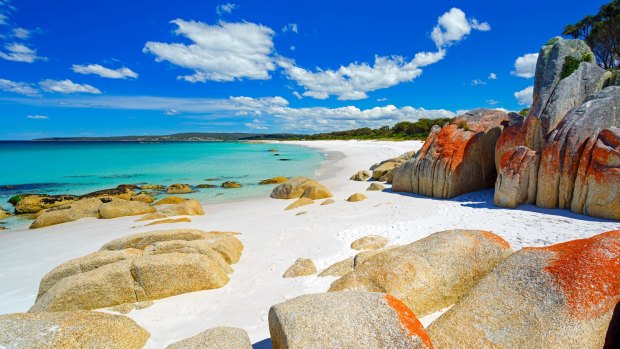
The Bay of Fires, Tasmania.Credit: SHUTTERSTOCK
The Bay of Fires has been doused. Rain pours over the normally luminous coastline, and waves brawl over rocks and a reef. On a good day, this is arguably the most beautiful slice of coast in Tasmania, and yet today the dulled views seem almost incidental.
I'm hiking on the wukalina walk, a new four-day guided hike along Tasmania's north-east coast that's about so much more than its pretty beaches. The first tourism venture from Tasmania's Aboriginal community, the walk brings together culture and scenery, weaving stories, bush tucker, living culture and millenniums-old traces of Aboriginal existence into the immense beauty of the Bay of Fires region.
It's an area that was home to Tasmania's North-east Aboriginal nation, with up to 500 people living here at any time. When English explorer Tobias Furneaux sailed past in 1773, he named the Bay of Fires for the Aboriginal fires burning along the coast. Perhaps most fitting of all to the wukalina walk, the area around St Helens, now the area's largest town, was known to Aboriginal people as "kunnara kunna", meaning "easy walking place". It's an apt description.
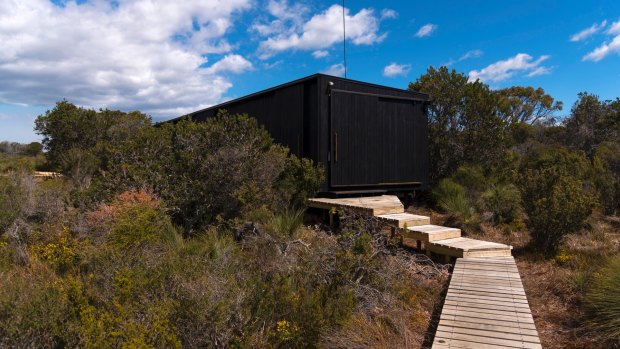
The Wukalina walk.Credit: Rob Burnett
We begin the walk on the eponymous wukalina. In this unusually flat corner of Tasmania, this 215-metre-high hill is what constitutes a mountain, and was indeed rather grandiosely named by Europeans as Mount William. It's now the centrepiece of Mount William National Park, with the mountain peeping above grassy clearings that are studded with grazing wallabies, Forester kangaroos and wombats.
It's a short walk to wukalina's tip – about 45 minutes – climbing through slopes flaked with granite outcrops. Though the summit is low, it's still a significant point, with a view that takes in the islands that run north in an ellipsis along the fringe of Bass Strait.
Aboriginal people used this summit to send messages to the islands, lighting fires to communicate. "One fire meant people coming from the islands, and two fires meant leaving," says Ben Lord, one of three palawa (Tasmanian Aboriginal) guides on the walk, pointing to two indents in the summit rock.
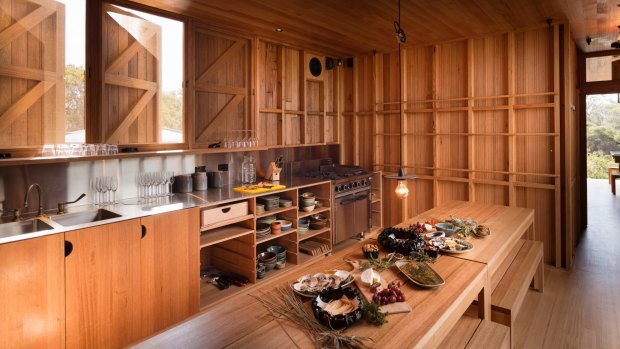
Food awaits the Wukalina walkers.Credit: Rob Burnett
"I've wondered if they used those as fire pits. I've been on the mainland and seen fire pits that looked like that."
As we descend from the mountain we turn off the public trails at a cleverly hidden junction, swinging on to a faint trail built specifically for the wukalina walk. It's easy walking, as it will be every day, on what feels like a secret portal from mountain to sea. The murmur of the ocean beckons us forward, kunzea bushes scent the air like butterscotch, and at times we're weaving through swaths of grass trees like star bursts.
At a glance, it could be almost any section of coastal bush, but seen on this walk it's bush that talks. The green sheoak nuts suddenly become ways that Aboriginal people would assuage thirst, chewing on them as they walked. Among the grass trees, Ben forages beneath the foliage, pulling out a lump of sap like red amber.
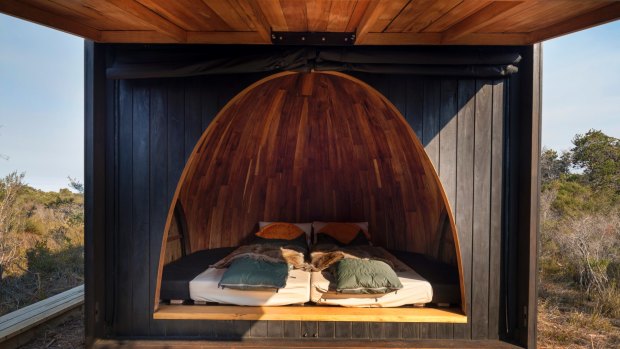
The sleeping pods.Credit: Rob Burnett
"This is what was used to make glue," he says. "Mix it with something fibrous like roo poo and it makes a really strong glue."
As we hit the coast, we also arrive at wukalina walk's beautifully designed krakani lumi camp, where a series of cube-shaped sleeping pods are dotted through the scrub. A large communal hub slides open to reveal a domed lounge area, replicating the shape of the shelters traditionally used by local palawa. The dome looks out onto a fire pit where, as we wander into camp, a dinner of muttonbird and wallaby is already cooking.
There are neat touches throughout the camp, from kelp fruit baskets, made by Aboriginal elders, in the kitchen, to warming wallaby skins that cover the beds and the hub's beanbags.
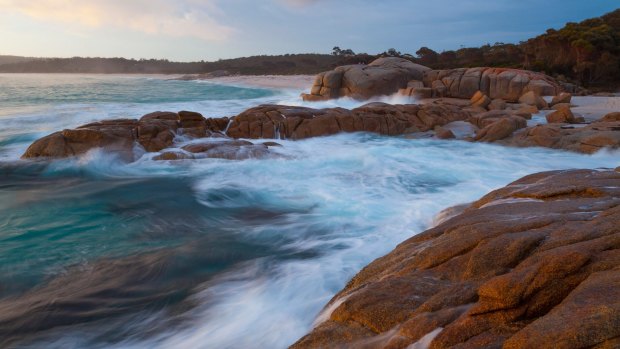
The Bay of Fires, Tasmania.Credit: Alamy
The sleeping pods crank open with an ingenious winch system, one wall lifting to reveal the entrance to safari-tent-style rooms, also shaped like domes. Blackout curtains hold the dawn at bay, leading to languorous, slow-to-stir mornings.
"That's the best sleep I think I've ever had," one walker announces the next morning.
In the evening, the camp is visited by palawa elders, who recount local creation stories in a yarning circle around the fire pit. Among them this night is Clyde Mansell, chairman of the Aboriginal Land Council of Tasmania and the progenitor of the wukalina walk. For Clyde it has been a project more than a decade in the making.
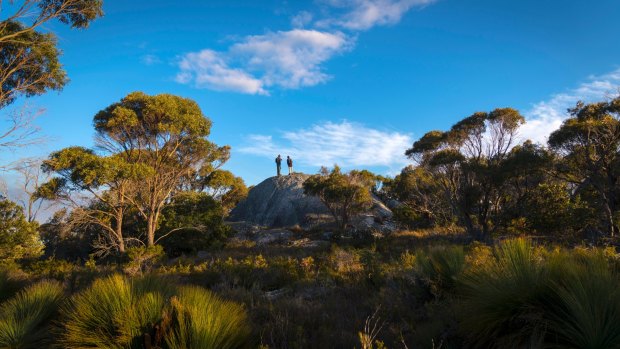
The Wukalina walk.Credit: Rob Burnett/Tourism Tasmania
"It just came about as a result of a desire to have something on country that allowed us to tell stories and to bring people out here to learn a bit of our culture," Clyde says. "The walk includes all the natural attributes of the land, but it's also about getting a cultural story happening."
Running like a white stripe across the front of the camp is a classically spectacular north-east beach. It's this beach that will form the core of our second day – one of gentle exploratory walks in the camp's vicinity, designed to refresh us ahead of wukalina's longest walking day.
The day dawns fiercely. A strong southerly wind whips the beach into a blur of sand, and pelicans blow across the sky. Along the sand, the ocean has deposited a bounty of curiosities: shark eggs, bluebottle jellyfish, leathery antlers of bull kelp.
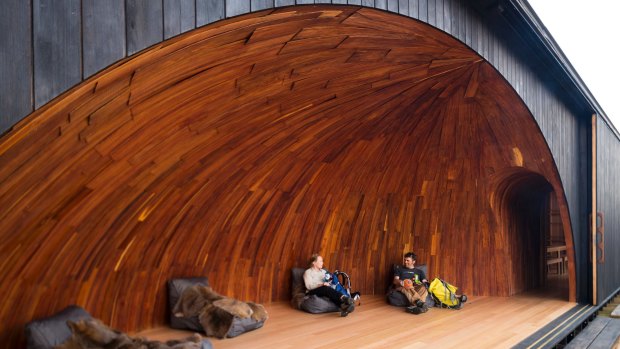
Relaxing in the krakani lumi camp.Credit: Rob Burnett
But the most impressive thing here isn't natural. On a sandy point near camp we come to a dune that is an Aboriginal shell midden, rising metres over our heads. The discarded shells of ancient meals gleam across its surface.
"This is like a dinner table to us," Ben says. "People would eat and throw the shells over their shoulders. It hurts my brain to think of how many meals had to be eaten to make a midden this size." It's a window into thousands of years of seafood dinners.
The third day will see us walking 17 kilometres of coastline to larapuna – the Bay of Fires – following the paper-white beaches to Eddystone Point Lighthouse. Rounded boulders huddle like colonies in the sea, and the horizon is a lumpy line of swell. It's an impossibly beautiful scene, even under a steel-grey sky.
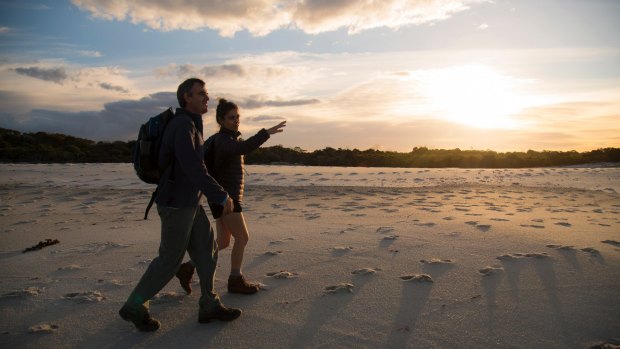
Taking in the sights on the wukalina walk.Credit: Rob Burnett
Along the coast, the beaches are broken by bouldery headlands smothered in orange lichen. They're classic north-east scenes, especially with the Bay of Fires now just steps away.
At Picnic Corner, we turn up into a break in the dunes, climbing over the narrow Eddystone Point, crossing to the Bay of Fires, where the ocean this day is indeed in a fiery mood. Waves slam down on to one another, and the air is blurred with sea spray and rain.
At the end of this beach, just a few hundred metres away, we turn back up on to the point, climbing to the lighthouse keepers' cottages. A wombat and its joey graze along the edge of a cottage in the finest of Tasmanian welcomes.
One of the restored cottages will be our home this final night. Inside, Aboriginal art work hangs over a fireplace, a leather sofa invites relaxation in the lounge, and a roast is in the oven.
Immediately above the cottage, the 35-metre-high Eddystone Point Lighthouse rises like a granite spike. The lighthouse was constructed atop an Aboriginal midden in 1889, and by most contexts it would be a historic structure, but even here it's more like yesterday when compared with the Aboriginal relics that surround it.
On the final morning we walk around the lighthouse grounds, where another large shell midden cascades down the slopes, and hut depressions from ancient Aboriginal shelters dimple the land.
The walk's steepest climb comes this morning – inside the lighthouse, ascending on the elaborate spiral staircase that coils its way up to the light. From the metal deck around the top, there's a view along the length of the north-east coast, which is finally lit by sun. It's a coast I've visited and walked many times, but suddenly the view looks and feels very different, for it's now etched in stories and culture.
"I feel so lucky to be here," one walker comments.
"That's the country," Ben says. "It's such a special place. It's like coming home for us."
FIVE OTHER NORTH-EAST TASMANIA ACTIVITIES
BAY OF FIRES LODGE WALK
Wander for two days along the Bay of Fires coastline, with a third day kayaking on Ansons Bay. Two nights are spent in the wonderful Bay of Fires Lodge, complete with spa treatments. See taswalkingco.com.au
BLUE DERBY PODS RIDE
Ride the world-class mountain-bike trail network at Derby, sleeping among the trails in comfy pods with a side serve of luxury and fine Tasmanian food and wine. See bluederbypodsride.com.au
FLINDERS ISLAND WALKING ADVENTURE
Head offshore for almost a week of beautiful day walks along Flinders Island's coast and mountains. See tasmanianexpeditions.com.au
FLINDERS ISLAND KAYAKING
If you'd prefer to see Flinders Island from the water, try a six-day paddle, exploring its many nooks and bays. See roaring40skayaking.com.au
BARNBOUGLE
If your idea of a good walk involves a golf club, the two links courses among the dunes at Barnbougle have been rated among the world's top 40 courses. See barnbougle.com.au
TRIP NOTES
MORE
FLY
Virgin Australia flies direct to Launceston, where the trip begins, from Sydney and Melbourne. See virginaustralia.com
TOUR
The wukalina walk is a four-day hike, staying two nights at the krakani lumi camp and one night in the lighthouse keepers' cottage at Eddystone Point. Trips run from November through April and cost $2495. See wukalinawalk.com.au
The writer travelled as a guest of wukalina walk.
See also: 10 of Australia's most amazing natural wonders are all in Tasmania
See also: Six of the best Tasmanian day walks
Sign up for the Traveller Deals newsletter
Get exclusive travel deals delivered straight to your inbox. Sign up now.